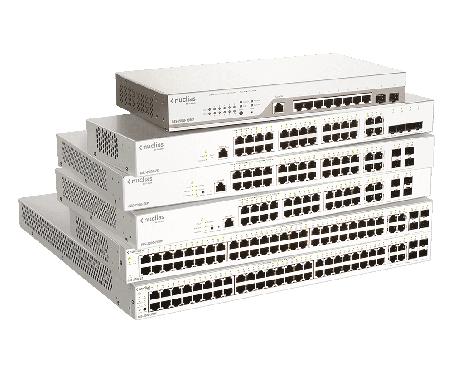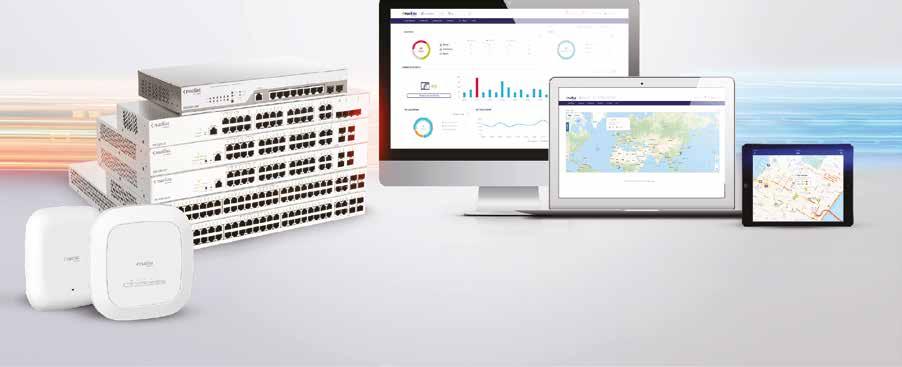






































The digital economy, by its borderless nature, has facilitated businesses across new frontiers and enabled innovation at breakneck speed, presenting great opportunities for progress and development and at the same instance also throwing up several challenges. Real-time collaboration between teams or employees working out of any location across the world has rewritten the economics of productivity. The distributed workforce has every opportunity to remain as effective as they would be in a conventional workplace, provided their work is measured in terms of well-defined KPIs and not necessarily in terms of hours spent at the desk. Industries are being reshaped even as smaller-sized Businesses too are enabled by digital technologies to compete with larger corporations and access global markets.
E-commerce has seen a massive shift in the past few years and a rising number of the global population is now comfortable with online purchases from the major e-commerce platforms. The mode of payments continues to transform with contactless cards to mobile wallets driving the shift away from physical cash towards a truly digital financial ecosystem.
The ease of transactions has indeed been significantly enhanced with tap-and-go or scanand-pay options. Digital transactions offer enhanced security as they are encrypted and authenticated. On the other hand, mobile payment platforms in many developing and underdeveloped markets have played a key role in enhancing financial inclusion for people with no or minimal access to banking services.
It has been a rollercoaster ride of digital acceleration in the past several years and we have seen the advent and adoption of several new technologies at a relentless pace. Almost overnight, the compulsions of the pandemic drove us to embrace the digital era more wholeheartedly than we would have ever done in more ‘normal’ times. The roller coaster ride is set to continue further as we navigate a disruptive future in an era that will be undeniably dominated by Generative AI and other emerging technologies.
RAMAN NARAYAN
Co-Founder & Editor in Chief narayan@leapmediallc.com Mob: +971-55-7802403
Sunil Kumar Designer
R. Narayan Editor in Chief, CXO DXSAUMYADEEP HALDER
Co-Founder & MD saumyadeep@leapmediallc.com Mob: +971-54-4458401
Nihal Shetty Webmaster
MALLIKA REGO
Co-Founder & Director Client Solutions mallika@leapmediallc.com Mob: +971-50-2489676











As in recent years, the healthcare sector continues to witness an ongoing tectonic shift towards data-driven, patient-centric digital transformation that is also streamlining operations.
The inaugural edition of the event focused on the theme ‘Role of Technology in Enabling Business Transformation & Resilience.

MBUZZ has rapidly expanded the range of solutions it offers through tie-ups with leading vendors and has invested in growth segments like AI solutions. Sabir Saleem, CEO at MBUZZ Technologies discusses various aspects of the company’s growth journey.
Omar Akar, Regional VP, Middle East & Emerging Africa, Pure Storage says enterprises must design an AI journey that adds the right value for their unique business model in a way that is measurable.
Legacy infrastructures are blocking the way forward for many regional enterprises wanting to adopt AI and the way forward is to partner with players who can help them, says Rindhir Singh, Head of Practice, Connectivity and Cloud at NTT DATA MEA.

32
Ekta Puthran, Head of Sales APAC & MEA - Collaboration, Barco writes that the future workplace needs to become an inclusive environment where employees are productive and can easily collaborate, whether they're working from home or in the office.
When basic security controls such as MFA and password enforcement are not in place, your organization is vulnerable writes Morey Haber, Chief Security Advisor, BeyondTrust.

Company delivers an Enterprise AI foundation in collaboration with NVIDIA

Nutanix, a leader in hybrid multicloud computing, announced new functionality for Nutanix GPT-in-a-Box, including integrations with NVIDIA NIM inference
microservices and Hugging Face Large Language Models (LLMs) library. Additionally, the company announced the Nutanix AI Partner Program, aimed at bringing together leading AI solutions and services partners to support customers looking to run, manage, and secure generative AI (GenAI) applications on top of Nutanix Cloud Platform and GPT-in-aBox. Nutanix GPT-in-a-Box is a full-stack solution purpose-built to simplify Enterprise AI adoption with tight integration with Nutanix Objects and Nutanix Files for model and data storage.
"We saw a great response to our original launch of Nutanix GPT-in-a-Box, validating the needs of Enterprise customers for on-premises software solutions that simplify the deployment and management of AI models and inference endpoints,” said Thomas Cornely, SVP of Product Management at Nutanix. "Enterprise is the new frontier for GenAI and we're excited
to work with our fast growing ecosystem of partners to make it as simple as possible to run GenAI applications on premises at scale while maintaining control on privacy and cost."
The company announced GPT-in-a-Box 2.0, which will deliver expanded NVIDIA accelerated computing and LLM support, along with simplified foundational model management and integrations with NVIDIA NIMs microservices and the Hugging Face LLM library. GPT-in-a-Box 2.0 will include a unified user interface for foundation model management, API endpoint creation, end-user access key management, and will integrate Nutanix Files and Objects, plus NVIDIA Tensor Core GPUs.
GPT-in-a-Box 2.0 will bring Nutanix simplicity to the user experience with a builtin graphical user interface, role-based access control, auditability, and dark site support, among other benefits.
Dennis Woodside takes over as new CEO while Girish Mathrubootham transitions to the role of Executive Chairman
Freshworks Inc announced the appointment of Dennis Woodside as Freshworks’ Chief Executive Officer & President.
Woodside, currently Freshworks’ President, will succeed Girish Mathrubootham, the company’s Founder, as CEO. Mathrubootham will transition to a new role of Executive Chairman. Mathrubootham will remain the chairman of the Board of Directors, and Woodside will also remain a member of the Board of Directors.
Since founding Freshworks in 2010, Mathrubootham has transformed Freshworks from a fledgling startup in Chennai into a leading SaaS company headquartered in San Mateo, with products that make it easy for every business to delight their employees and customers. Mathrubootham steered Freshworks through an IPO on Nasdaq in September 2021, making Freshworks the first India-born SaaS firm to trade on a US exchange.
 Dennis Woodside CEO & President Freshworks
Dennis Woodside CEO & President Freshworks
Woodside joined Freshworks as President in September 2022. Since then, Woodside has accelerated Freshworks’ investments in enterprise grade products, and driven increased focus on the growth of mid-market and enterprise customers.
Woodside brings great leadership experience to this new role. Previously, Woodside served as Chief Operating Officer of Dropbox, helping grow revenue from $250M to $1.3B and ultimately raising over $1B in a successful IPO in 2018. Prior to that, Woodside held various sales and strategy leadership roles at Google from 2003 to 2014, including serving as CEO of Motorola Mobility after Google acquired the company in 2012.
In his new role as Executive Chairman, Mathrubootham will remain highly engaged with the company's product vision, customers, and employees.
Lenovo focuses on democratizing AI and making intelligent infrastructure solutions accessible to businesses of all sizes Lenovo, a global technology leader, has chosen VAD Technologies as its Value-Added Distributor for the Middle East. VAD’s robust channel partner ecosystem and rapid growth in the high-performance data center solutions space make them an ideal partner to promote Lenovo Infrastructure Solutions Group (ISG) portfolio and smart infrastructure solutions.
Lenovo’s cutting-edge technology and insights drive advancements in smarter retail, manufacturing, cities, healthcare, finance, and more. Through edge and cloud computing, analytics and artificial intelligence, and Infrastructure-as-a-Service via TruScale, Lenovo delivers Smarter Technology for All. As the only data center provider with end-to-end manufacturing capabilities, Lenovo ensures unmatched security and seamless integration by controlling the entire supply chain.
This partnership will ensure that Lenovo’s ISG products, including its extensive Al-
liances Products & Solutions Catalogue, are readily available to partners across the region. VAD Technologies’ channel partners—including system integrators, VARs, MSPs, CSPs, and IT resellers—will benefit from VAD’s in-depth expertise in the data center, cloud, cybersecurity, and AI markets, along with comprehensive technical support, pre-sales capabilities, and financial services.
Alaa Bawab, General Manager, Lenovo Infrastructure Solutions Group, META said “At Lenovo, we're committed to democratizing AI and making intelligent infrastructure solutions accessible to businesses of all sizes across the globe. Our partnership with VAD Technologies is a significant step forward in achieving this goal.
Mario Veljovic, General Manager of VAD Technologies, stated, “Our group has successfully collaborated with Lenovo in Saudi Arabia for many years, and we

are thrilled to now expand our partnership across the Middle East region. Lenovo’s product portfolio complements our existing high-performance data center solutions and aligns with our market vision.
SaaS Manager Plus Provides Easy Discovery and Optimization of SaaS Subscriptions to Cut SaaS Costs and Maximize ROI and Productivity
 Rajesh Ganesan President, ManageEngine.
Rajesh Ganesan President, ManageEngine.
ManageEngine, a division of Zoho Corporation and a leading provider of enterprise IT management solutions, today announced the launch of SaaS Manager Plus, a SaaS management solution for enterprises.
SaaS Manager Plus seamlessly integrates with Zoho apps and other widely utilized applications, empowering IT admins and finance managers to streamline their SaaS ecosystems and identify cost-saving opportunities for better budget allocation.
With organizations rapidly switching to cloud-based applications comes a massive challenge for IT teams—SaaS sprawl. Businesses struggle to discover all the SaaS applications employees are using, manage access permissions and ensure secure usage across a geographically distributed workforce.
SaaS Manager Plus tackles these challenges head-on by providing a unified platform for SaaS management. It streamlines discovery, enforces access controls
and offers valuable usage insights, allowing IT teams to gain control over their SaaS ecosystems, optimize costs and ensure data security, all while empowering a productive remote workforce.
"While multi-Cloud and multi-SaaS strategies offer enormous benefits, inefficient use of cloud resources and spiraling costs could topple business operations. A disciplined FinOps approach could help, but most organizations struggle to align it well with their management practices across IT, Finance, Operations, etc. Saas Manager Plus brings one of the key FinOps components to ManageEngine, which continues to evolve into a platform, thereby addressing this challenge for our customers," said Rajesh Ganesan, president at ManageEngine.
Inaugural Summit showcases growth and AI innovation in Qatar

Google Cloud celebrated the one-year anniversary of its launch of the Doha Google Cloud region with the inaugural Google Cloud Doha Summit. Under the esteemed patronage of His Excellency Mr. Mohammed bin Ali Al Mannai, Minister of Communications and Information Technology, the event marked a year of remarkable progress, innovation, and collaboration in Qatar's digital landscape.
The summit, held at Stadium 974 in Doha, brought together more than 1,000 attendees, including Google Cloud partners, customers, government officials, and industry leaders, to commemorate the achievements of the past year and explore the future of cloud computing and AI. It also stood as a testament to the growth and potential witnessed in Qatar's digital ecosystem, thanks to the visionary leadership of H.E. Mr. Mohammed bin Ali Al
Mannai, Minister of Communication and Information Technology.
Abdul Rahman Al Thehaiban, Managing Director, Turkey, Middle East & Africa, Google Cloud said: “As Google Cloud looks ahead, the commitment to Qatar's digital and knowledge-based economy remains steadfast. Continued investment in infrastructure, introduction of new services and features, and fostering a thriving ecosystem of partners and developers will unlock the full potential of Qatar's digital landscape.”
The Doha Google Cloud region, the first of its kind in the Middle East and Africa, has witnessed significant adoption of Google Cloud's innovative services and solutions by businesses across various sectors over the past 12 months.
The partnership focuses on offering businesses tailored solutions that adapt to evolving needs and stringent regulatory standards
Finesse, an industry leader in digital transformation, has made waves with its recent announcement of a strategic alliance with Defensys, a prominent cybersecurity solutions developer headquartered in Singapore. Since 2011, Defensys has been at the forefront of pioneering software products and services aimed at fortifying businesses and government organizations against modern cyber threats while ensuring robust security management on a global scale.
With an unwavering commitment to empowering businesses and government bodies worldwide, Defensys’s mission resonates deeply with today’s digital landscape, where cyber threats loom large across various sectors, from banking and government to oil and gas, energy, and metallurgy.
The collaboration between Finesse and Defensys signifies a monumental leap forward in offering businesses tailored solutions that adapt to evolving needs and stringent regulatory standards. By leveraging Finesse’s established expertise in digital transformation and Defensys’s cutting-edge technology, this partnership promises to redefine the landscape of security and compliance solutions.
Sunil Paul, Managing Director at Finesse, shared his enthusiasm

for the collaboration, stating, “This partnership with Defensys represents a pivotal moment in our commitment to delivering comprehensive GRC solutions . With a strong focus on cybersecurity, this collaboration enables us to provide state-of-the-art risk and compliance solutions, empowering our clients to navigate the ever-evolving digital terrain with confidence and resilience.”
Sophos seeks to expand mid-market presence
Sophos, a global leader of innovative security solutions for defeating cyberattacks, announced that Joe Levy is now chief executive officer (CEO) of the company. Levy has been acting CEO since Feb. 15. To drive a critical role in the execution of his strategy to shape the future of Sophos, Levy has named Jim Dildine Sophos’ new chief financial officer (CFO) and a member of his senior management team.
During his nine-year tenure at Sophos, Levy drove the transformation of Sophos from a product-only vendor into the global cybersecurity giant it is today, including an incident response team and managed detection and response (MDR) service that defends more than 21,000 organizations worldwide. Levy also created SophosAI and Sophos X-Ops, an operational threat intelligence unit that joins together more than 500 cross-departmental cybersecurity operators and threat intelligence experts.
As CEO, Levy plans to expand Sophos’ already strong customer base in the mid-
market, which includes nearly 600,000 customers worldwide and generates more than $1.2 billion in annual revenue. As a leading provider of cybersecurity solutions for the midmarket, Sophos has a unique ability to further scale its business and the business of its partners by helping organizations in dire need of basic and expanded defenses against opportunistic and targeted cyberattacks. These organizations include the critical substrate, small- to mid-sized organizations that comprise the machines of the world’s economy and are just as susceptible to cyberattacks as major corporations.
“Our goal is to help more organizations in the midmarket – the estimated 99% of organizations that are below the cybersecurity poverty line – be better at detecting and disrupting inevitable cyberattacks. Our envisioned approach to achieving this is to work with MSPs and channel partners that can scale alongside us with our innovative critical cross domain technologies – endpoint, network, email, and cloud security

Levy
CEO, Sophos– and managed services that they can resell and co-deliver. Cyberattacks against the midmarket could severely impact the world’s ability to function; they are relatively under-protected compared to the 1%, and Sophos is on a mission to change that.”
Company signs up distributors to address the needs of Africa’s young and rapidly growing digital economy
Lexar, a leading global brand of flash memory showcased its latest range of high-capacity memory solutions that are among the fastest of its kind in the world at the 2nd edition of GITEX Africa held from 29-31 May 2024 in Marrakesh, Morocco.
Morocco is a key market for Lexar in the context of the company’s strategic plans in Africa, as government strategy for digital transformation aims to create a suitable environment for digitization of Morocco’s administration and economy and aspires to become a digital regional hub. In the past 12 months Lexar has signed strategic agreements with multiple distributors and retailers in Morocco in line with its plans to build its brand presence and meet the growing demand for next-generation memory solutions. Lexar’s key distributors in Morocco include Digimate - han-

dling volume distribution; DBM Maroc- a leading systems integrator in Morocco; and Abschir - handling Lexar’s imaging products distribution. These three major
distributors that Lexar has signed up in Morocco to market and sell its product range will also enable the company to strengthen its local customer support and product offering.
Fissal Oubida, General Manager – Middle East, Africa and India, Lexar, said, “Uniting leading global tech companies to advance Africa’s digital economy is a key mandate of the Moroccan government. Morocco is one of the most technologically advanced countries in Africa and its strategic location as a geographical and cultural bridge between Africa and Europe make it a major trade hub in the region.”
In Morocco, Lexar is now available in more than 500 independent retail sale points, including Marjan, Aswaq Salaam, Virgin, Carrefour, Electroplanet, and Retail Expert among others.
New open Platform optimizes digital experiences by leveraging full-fidelity data and AI to automate prevention, identification, and resolution of IT issues
Riverbed, a leader in AI Observability, introduced an advanced AI-powered observability platform to optimize digital experiences, and launched several new solutions and a unified agent built on this open architecture. Expanding on its broad collection of full-fidelity data across the IT landscape, Riverbed’s new observability capabilities now enable IT to overcome visibility blind spots around public cloud, Zero Trust and SD-WAN architectures, and remote work environments. Additionally, with Aternity Mobile, IT can now monitor enterprise-owned Apple iOS and Android mobile device performance to proactively identify digital experience issues and take targeted actions to improve the productivity of front-line employees.
The Company also released the next generation of Riverbed IQ 2.0, an AIOps service that reduces alert fatigue and enables
IT to identify and solve issues faster by using AI-driven correlation and automation of Riverbed and third-party data.
“Customers are challenged with improving the digital experience, simplifying their management environment and implementing AI that works and scales,” said Dave Donatelli, Chief Executive Officer at Riverbed. “To address this, Riverbed has invested in our core competencies of data collection and AI, and we’re launching the most advanced AI-powered observability platform to optimize digital experiences, along with solutions that provide new levels of visibility into network blind spots and enterprise-owned mobile devices.”
The new Riverbed Platform is open, simple, and smart, enabling IT organizations to collect, analyze and automate, and report on data, in order to deliver optimized
 Dave Donatelli CEO, Riverbed
Dave Donatelli CEO, Riverbed
digital experiences. The Riverbed Platform collects full-fidelity data spanning networks, IT infrastructure, applications, user experience, endpoints, and cloud.
The SOC also hosts a team of OT threat analysts, IEC 62443, NIST, NIS2, and other compliance experts, and an OT Security testbed

DigiGlass by Redington, Managed Security Services Distributor (MSSD), and Sectrio, a global leader in OT/ICS and IoT cybersecurity solutions, cyber threat intelligence, and managed security services inaugurated the first Industrial Control System/Operational Technology Security Operations Center (SOC) with a device testing lab in Dubai.
The facility built for ICS/OT SOC hosts cutting-edge solutions, services, and consulting expertise primed towards countering existing and emerging cyber threats along with a device testing lab dedicated to OT systems is the first of its kind in the UAE. In addition, the SOC also hosts a team of OT threat analysts, IEC 62443, NIST, NIS2, and other compliance experts, and an OT Security test-
bed to stress test OT assets from a security perspective. For businesses that seek to elevate their OT/ICS security posture rapidly, the SOC offers:
• Solutions and managed security services focused on core OT/ICS cybersecurity requirements delivered using proprietary frameworks
• Greater control over the cost of capital deployed for securing OT/ICS infrastructure
• OT/ICS and IoT-focused industry-leading expertise to monitor, prevent, detect, investigate, and respond to global cyber threats
• Contextual and rapid incident detection and response capabilities to contain sophisticated threats
• Largest pool of experienced OT security professionals
• A path to rapidly scale OT security posture while dealing with in-house resource, skill, and expertise constraints
Solution built specifically for the supply chain industries

Epicor has unveiled its new Epicor Grow portfolio, an integrated set of AI and BI capabilities powered by an industry-focused data platform tuned specifically for the requirements of the make, move, and sell industries.
“We know the keys to realizing the full power of AI revolve around two important things: applying AI to a well-defined, practical business issue, and leveraging high quality data,” said Epicor Chief Product & Technology Officer Vaibhav Vohra. “Our new Epicor Grow portfolio delivers on both fronts, putting workers at the center of the intelligence ecosystem.”
Core elements of the integrated portfolio include:
Epicor Prism - Epicor Prism is a patent-pending generative AI service embedded across the Epicor Industry ERP Cloud that empowers workers to access the right insights, in the right context, at the right time to make smarter decisions.
Epicor Grow AI - Epicor Grow AI surfaces insights with high speed and accuracy to solve industry-focused challenges in the context of a customer’s Epicor solutions.
Epicor Grow Inventory Forecasting –From Epicor’s recent acquisition of Smart Software, users can leverage predictive analytics and model “what-if” scenarios to better manage inventories with embedded, purpose-built, machine-learning forecasting engines.
Epicor FP&A – Deeply embedded Financial Planning and Analysis capabilities for easy, accurate, and thorough financial reporting.
Epicor Grow BI – Easy-to-use no-code technology joins and transforms data with elegant visuals, metrics, and dashboards.
Epicor Grow Data Platform - A powerful way to manage enterprise data in one place with a full-stack, no-code data platform that delivers fast time to insight with deeper visibility.
Partnership will enable partners and customers to build comprehensive data resilience strategies
Exclusive Networks, a leading cybersecurity value-added distributor announced a strategic agreement with Veritas a leader in secure multicloud data resilience, to deliver world-class data management solutions to businesses across the region. This commitment will empower partners and customers to build comprehensive data resilience strategies and navigate the ever-evolving data landscape with confidence.
Veritas offers a comprehensive portfolio of solutions for backup, recovery, data governance, and multi-cloud management, enabling businesses to protect their critical data assets across complex IT environments. Exclusive Networks boasts a robust network of channel partners and a deep understanding of the regional market, ensuring efficient distribution and support for Veritas’ solutions.
Ramzi Itani, Regional Director of Emerging Region at Veritas Technologies said, “Given the rampant threat of ransomware, every organization needs a cyber resilience strategy and Veritas NetBackup, NetBackup appliances, and Alta data protection offerings, deliver an integrated solution. Combining the best technology and working with Exclusive Networks gives our customers across KSA a competitive advantage.”
“Data has become the lifeblood of modern businesses, and ensuring its resilience is paramount,” said Grant Taylor, General Manager – Middle East at Exclusive Networks. “We are excited to join forces with Veritas to deliver their market-leading solutions to our partners and customers across the Kingdom of Saudi Arabia. This agreement will empower organizations to

build comprehensive data protection strategies and mitigate risk in the face of today’s complex data challenges.”

As in recent years, the healthcare sector continues to witness an ongoing tectonic shift towards data-driven, patient-centric digital transformation that is also streamlining operations.
Digital acceleration has been responsible for the extensive transformation of various industries in recent years. Healthcare stands out as a sector that has benefitted from the surge in technological advances that have vastly improved the services to patients including diagnosis and treatment as well as streamlined hospital operations.
Ramakrishnan Natarajan, Vice President Information Technology, Emirates Hospitals Group says, “Digital transformation has touched nearly every aspect of healthcare, from patient management to complex surgical procedures. Digitalization has streamlined administrative tasks, reducing the burden on healthcare staff and allowing them to focus more on patient care. For patients, it has meant faster, more accurate diagnoses and treatments, along with improved access to their medical records and health information.”
Digital acceleration has also helped improve data analytics, allowing healthcare organizations to collect large volumes of data and analyse them and helping manage their resources more efficiently and deliver superior service to patients. The availability of real-time analytics and the integration of digital tools has seen a leap towards data and patient centric healthcare. It enables healthcare providers to make informed decisions, optimize operations, and deliver high quality care. By analyzing patient data, healthcare providers can identify trends and potential health issues before they become critical.
Aliasgar Bohari, Senior IT Director at Zulekha Hospitals says, “In recent years, the healthcare industry has undergone a significant digital transformation, particularly after COVID-19 pandemic. Technologies such as Telehealth, Artificial Intelligence, and RPA have been implemented by healthcare organizations. This transformation has been focused on improving
patient experiences and streamlining operations. Healthcare staff now have easier access to patient data and improved diagnostic accuracy allowing them to make data-driven decisions. It also allowed for better coordination and continuity of care through the HIE platform for exchanging medical records between healthcare providers such as NABIDH and RIAYATI. Patients have benefited as they have now increased access to healthcare through teleconsultation and also have more control over their health records allowing them to make informed decisions about their treatment options.”
According to Dr. Shijin Prasad, Director of IT at Cure Medical Centers, transformation in healthcare involves adopting advanced digital technologies to enhance care delivery and address medical challenges.
“This shift generates vast amounts of data, whose quality management can improve patient care and reduce costs. Key impacts
include using AI and machine learning for diagnostics, predictive analytics, and personalized medicine, which enhance diagnostic accuracy and treatment efficiency.”
Dr. Shijin also elaborates about other areas of significant impact in healthcare. “mHealth apps and wearables promote proactive health management through real-time monitoring, and robotics enhance surgical precision and automate routine tasks, as seen in some UAE hospitals. Big data and analytics support better population health management and evidence-based decision-making, while blockchain ensures secure and transparent medical record management. IoT facilitates seamless device communication and data exchange, and electronic health records (EHRs) streamline patient information access and updates. Telemedicine, accelerated by the COVID-19 pandemic, enables remote consultations, reducing the need for in-person visits.”
According to Jaleel Jaleel Rahiman, Director - IT & PRIME Digital at PRIME Healthcare Group, “In recent years, digitalization in the healthcare sector has seen significant advancements globally, including in the UAE. In the UAE, EHRs have been the norm for quite some time, replacing paper records and facilitating easier access to patient data for healthcare providers. The UAE government has implemented initiatives such as Malaffi, NABID, and Riayati, which provide physicians with a holistic view of the patient’s medical history regardless of previous visit locations. These systems eliminate the need for patients to carry their earlier records from different providers, enhancing continuity of care and reducing administrative burdens. During the COVID-19 pandemic, there was a significant surge in the use of telemedicine. This trend has continued, with mobile health (mHealth) becoming increasingly prominent. Mobile applications are now widely used for monitoring health conditions, managing chronic diseases, and promoting wellness. Devices like fitness trackers, smartwatches, and patches are employed to monitor vital signs and physical activity, providing real-time data to both patients and healthcare providers.”
He also adds that these have resulted in increased benefits for both the healthcare staff and patients.
“Digital tools reduce administrative burdens, streamline workflows, and enhance communication among healthcare teams. There is better access to comprehensive and up-to-date patient information enables more accurate diagnoses and personalized treatment plans. Patients have more access to their health information and can actively participate in their care. Telemedicine and remote monitoring can reduce the need for in-person visits and hospitalizations, leading to lower healthcare costs. This is particularly beneficial in managing chronic diseases, where continuous monitoring and timely interventions can prevent complications and hospital readmissions.”
Muti-cloud adoption has seen a boost in the past few years driven by various factors including the necessity of leveraging the best of cloud services from multiple best in class cloud providers, managing pricing options better as well as achieving better efficiency in operations. While healthcare too has aligned with this trend in general, yet there are some reservations regarding security and complexity.
Aliasgar says, “Multi cloud adoption is gaining more adaptability and acceptance in the healthcare sector. It’s being recognized for its ability to enhance security and improve IT infrastructure. However, there are reservations about moving some of the workload to the cloud due to concerns such as budget constraints and the ability to measure return on investment (ROI). Healthcare organizations are very cautious since healthcare data contains healthcare records of patients which is very sensitive in nature and also healthcare organization needs to comply with strict regulatory complaints.”
Ramakrishnan agrees with the view that while the adoption of multi-cloud strategies is indeed gaining traction in the healthcare sector, some concerns remain.
He elaborates, “This approach allows healthcare organizations to distribute their workloads across multiple cloud environments, enhancing resilience, flexibility, and performance. It also helps in managing costs more effectively and ensures that critical applications remain available even if one cloud provider experiences an outage. However, there is still some hesitation about moving certain workloads to
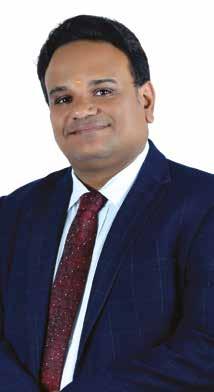
the cloud. Concerns about data security, compliance with regulatory requirements, and the potential complexity of managing multiple cloud environments are significant considerations. Despite these reservations, the trend is moving towards embracing the multi-cloud approach due to its many benefits.”
Dr. Shijin discusses how the UAE is embracing multi-cloud in the healthcare sector with necessary guidelines for data protection.
He elaborates, “In the UAE, health authorities are supportive of cloud adoption but mandate that data must reside within the country to protect patient privacy and comply with national regulations. Healthcare providers must adhere to the Authority Information Security Guidelines to ensure data security and privacy. In Abu Dhabi, the Department of Health (DOH) and the Abu Dhabi Health Information and Cyber Security (ADHICS) have published comprehensive information security guidelines that providers must follow. Cure Medical Centers are committed to complying with ADHICS guidelines, ensuring that we meet information security standards and successfully adopt cloud
 Senior IT Director, Zulekha Hospitals
Senior IT Director, Zulekha Hospitals
technologies. By adhering to these regulations, we aim to maintain the highest levels of data protection while leveraging the benefits of multi-cloud environments.”
AI and ML technologies are being utilized more and more in healthcare, especially as mentioned earlier, in analyzing vast amounts of data quickly and accurately, leading to better decision-making and predictive analytics.
Ramakrishnan elaborates, “For instance, AI algorithms can analyze medical images to detect anomalies faster than human eyes, assisting radiologists in diagnosing conditions like cancer at earlier stages. This capability not only speeds up diagnosis but also significantly enhances accuracy, leading to earlier and more effective treatment interventions. Machine learning models are also being used to predict patient outcomes, personalize treatment plans, and manage hospital resources more efficiently. This is particularly valuable in managing chronic diseases, where early intervention can prevent complications and improve the quality of life for patients.”
In addition to diagnostics and treatment planning, AI and ML are also transforming operational aspects of healthcare with AI-powered chatbots and virtual assistants
that are being used to streamline patient interactions, from scheduling appointments to providing preliminary medical advice. These tools are enabling superior patient interaction experiences and freeing up invaluable time for healthcare staff to handle more complex tasks. There are more use cases where AI can come in handy such as predicting patient admission rates, which aids in better resource allocation and reduces wait times. Further, they also play a key role in enabling and accelerating drug research and development.
Dr. Shijin discusses how Cure Medical Centers are adopting AI and ML in advancing their patient care.
He says, “Cure Medical Centers illustrate how AI-driven digital transformation platforms, utilizing Purplegrids AI-powered platform, elevate patient engagement and satisfaction. This technology orchestrates and customizes patient communications across multiple channels, optimizing workflows to enhance the patient journey and achieve healthcare provider objectives. Through AI-driven automation, personalized care, and efficient operations, they deliver measurable improvements in appointment scheduling, medication adherence, and overall patient satisfaction. Cure Medical Centers are also partnering with providers of Medical Coding AI Solutions to create a code search tool employing AI, ML, RPA, and NLP technologies. This innovative tool recommends pertinent codes based on patient records, simplifying the coding process for medical professionals.
According to Jaleel, AI and ML are being leveraged in various areas within the healthcare sector, demonstrating significant potential to transform patient care and clinical workflows.
“One mature use case of AI and ML in healthcare is in assisting radiologists with interpreting medical imaging studies. AI algorithms can analyze images faster and sometimes with greater accuracy, leading to quicker reporting and diagnosis. This aids in the early detection of conditions such as cancer, fractures, and other abnormalities, ultimately improving patient outcomes. AI and ML models are being developed to calculate risk scores for conditions like diabetes, hypertension, and mental health. These risk scores provide early warnings, en-
 Dr. Shijin Prasad IT Director, Cure Medical Centers
Dr. Shijin Prasad IT Director, Cure Medical Centers
abling patients and healthcare providers to take proactive measures. Furtrher, AI models are also being applied to personalize post-discharge care. By analyzing patient data, these models can identify individuals at high risk of readmission and tailor follow-up care to their specific needs. This not only reduces the likelihood of readmissions but also improves clinical outcomes by ensuring that patients receive appropriate and timely care after leaving the hospital.”
He adds that the applications of AI in healthcare are continually expanding such as Predictive Analytics and Clinical Decision Support. In summary, AI and ML technologies are helping advance diagnostic accuracy, enable early intervention, personalize patient care, and improve operational efficiency.
With a super critical sector like healthcare, data privacy is a top priority, and all patient data must be handled and secured with robust security.
Ali Asgar says, “Looking at the rise in cyber attacks especially in the healthcare sector, securing sensitive patient data against unauthorized access is very crucial. Moreover, keeping patient data safe and secure will build trust between patients and healthcare providers and it is also mandatory for
the healthcare provider to comply with strict data privacy regulations. Hence it is very important to ensure data privacy while leveraging advanced technology in the healthcare sector. In a nutshell, data privacy and security is not just a legal requirement, it is also a critical aspect of patient care.”
Globally, there are guidelines and regulations to be followed in healthcare. In addition to these, the UAE has also stringent data protection regulations in place. In the UAE, the emphasis on data privacy ensures not just compliance but also focuses on fostering a culture of security and trust within the healthcare sector.
Ramakrishnan says, “Compliance with regulations such as HIPAA in the US and GDPR in Europe is essential to safeguard privacy. These regulations mandate stringent controls over the collection, storage, and sharing of personal health information, ensuring that patient data is handled with the utmost care and confidentiality. In the UAE, specific data governance requirements are imposed by local laws and regulatory authorities, such as the Dubai Health Authority (DHA), Department of Health (DOH), and Ministry of Health and Prevention (MOHAP). These regulations are designed to ensure that healthcare providers adhere to high standards of data protection and privacy.”
The DHA's Health Data Protection Regulation mandates that all health data must be stored and processed within the UAE, and it sets out strict guidelines for data security, access controls, and patient consent. These regulations are aligned with global best practices but are tailored to address the specific needs and context of the UAE healthcare system.
“Healthcare organizations in the UAE must implement strong encryption, regular audits, and stringent access controls to protect patient data. Regular audits help in identifying and addressing potential vulnerabilities in the data management systems. Stringent access controls ensure that only authorized personnel can access sensitive patient information, minimizing the risk of data breaches. Additionally, healthcare providers must educate their staff on data protection best practices and the importance of maintaining patient confidentiality,” he adds.
Electronic Health Records (EHR) are an integral part of modern healthcare, transforming how patient information is stored, accessed, and utilized.
Ramakrishnan says, “They provide a comprehensive digital repository of patient data, making it easily accessible to healthcare providers across different locations. This accessibility ensures that patients receive consistent and coordinated care, regardless of where they seek treatment, significantly reducing the likelihood of errors and improving patient outcomes. One of the critical advancements in EHR systems is their integration with ERP systems. This integration connects EHRs with modules for supply chain management, finance, and human capital management (HCM). By linking these areas, healthcare organizations can streamline operations, improve resource management, and reduce costs.”
For example, integration with supply chain modules ensures that medical supplies are always available when needed, while integration with finance modules provides accurate and timely financial data, aiding in better budget management. HCM integration helps in managing staff efficiently, ensuring that the right personnel are available to provide care.
“In the UAE, the importance of a robust Revenue Cycle Management (RCM) module within EHR systems cannot be overstated. The RCM module automates claims processing with insurance companies and streamlines billing procedures, which is crucial in a region where insurance-driven healthcare is predominant. Automatic claims processing reduces administrative burdens, minimizes errors, and speeds up reimbursement, ensuring that healthcare providers can maintain financial stability and continue to deliver high-quality care,” he adds.
According to Aliasgar, “EHR (Electronic Health Records) are being utilized extensively in healthcare with nearly all healthcare facilities adopting EHR systems. It is being utilized in several impactful ways such as providing immediate access to the complete medical history of patients including patient visit records, complaints, allergies, diagnosis, investigation, medication, lab and radiology results, and re-
 Jaleel Rahimani Director - IT & PRIME Digital, PRIME Healthcare Group
Jaleel Rahimani Director - IT & PRIME Digital, PRIME Healthcare Group
port. They help provide alerts for potential drug interactions and allergies and enables information sharing between different healthcare providers through the HIE (Health Information Exchange) program such as NABIDH & RIAYATI, ensuring that healthcare providers have a complete view of patient health status and treatment history They also help automate the coding and billing process, reducing errors and streamlining administrative tasks as well as in documentation towards meeting regulatory compliance.”
He adds that EHR has been significantly improved through enhanced interoperability with standardized data formats like HL7 (a range of global standards for the transfer of clinical and administrative health data between applications) & LIONIC (an international standard for identifying health measurements, observations, and documents).
The continuous improvement and integration of EHR systems are pivotal in advancing healthcare. The integration of EHRs with ERP systems, enhancing RCM capabilities, leveraging AI and ML technologies, and integrating with biomedical solutions help deliver more efficient, accurate, and personalized care. This integration is key to working towards a holistic healthcare system that is efficient operationally and effective in delivering patient care.
The inaugural edition of the event focused on the theme ‘Role of Technology in Enabling Business Transformation & Resilience

The CIO Connect Summit & Awards organized by Leap Media Solutions on May 13th, the publisher of CXO DX brought together an industry gathering of CXOs and facilitated a day full of informative sessions that helped map the latest in technology trends. Held at the JW Marriott Hotel in Dubai Marina hotel, the event was also a platform for Technology leaders to have purposeful conversations with several leading Technology providers who were among the exhibitors at the event.
The event focused on the theme ‘Role of Technology in Enabling Business Transformation & Resilience’ and had a lineup of keynotes and discussions led by industry and technology experts. The discussions at the event focused on topics from cloud to the edge, Generative AI and Ml to cybersecurity solutions, and data mod-
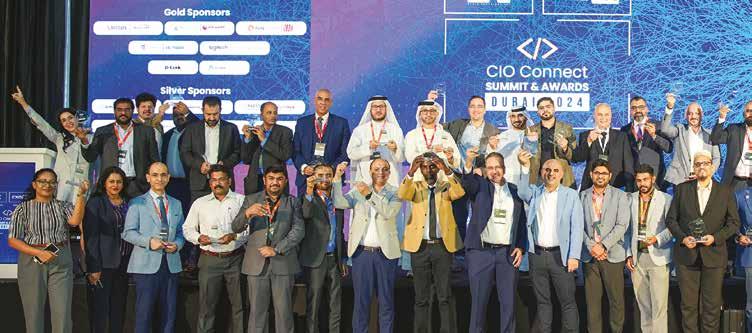
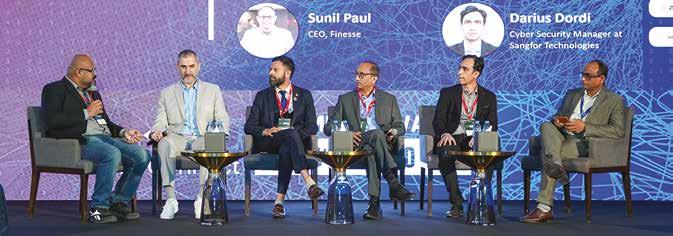
ernization that are enabling and securing business transformation.
The event also included Awards that recognized outstanding individuals who have been playing a key role in IT transformation initiatives in the industry as well as companies that are significantly driving the Transformation trends through the solutions they bring to market.
Dell Technologies and Ingram Micro were the Platinum sponsors at the event. The Gold sponsors of the day included Logitech along with Alpha Data, Extreme Networks with Ingram Micro, Freshworks and DM World, Pure Storage with VAD Technologies, Accops with Bulwark Technologies as well as D-Link and Mindfire Technologies.
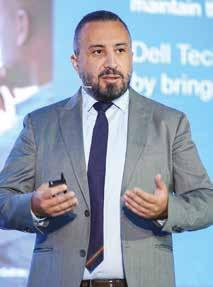
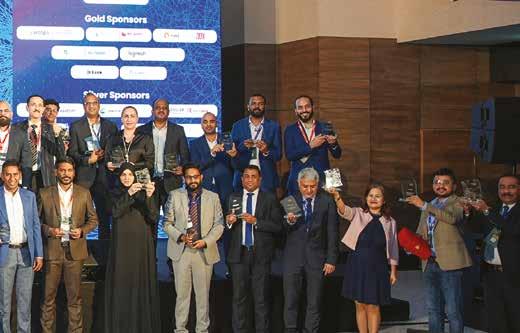
The silver sponsors included Paessler, Finesse, Amviz with ExtraHop, ManageEngine and Cloud Box Technologies, Sophos as well as Sangfor with DVCOM.
The Awards categories included recognitions for IT Leadership, Sustainability Excellence and CyberSecurity Excellence, given to senior Technology leaders of leading companies from different verticals. There were also Awards given to recognise outstanding IT Managers from different verticals helping the cause of digital transformation at their companies.
Among the speakers of the day, Charbel Zreiby, Regional Director, Channel Data Center Specialists, Dell Technologies spoke on ‘Bring AI to your Data with Dell Technologies’. Following him, Ahmad El Soufi, Regional Senior Presales Consultant, Extreme Networks presented on ‘One Cloud to manage one network’.
“Innovation, Technology and Sustainability’ was the focus of the third keynote of the day by Samer Semaan, Director Distribution and Alliances – Middle East, Turkey and Africa at Pure Storage. Aamir Mushtaq Shaikh, Lead – Channel Partnership and Alliance (Middle East) at Freshworks, the next speaker of the day spoke on ‘ In IT Together: Harnessing AI for better Workplace Experiences”
Shyam Sundar Chelnat, Regional Sales Manager from Accops MEA presented on ‘Uncomplicate Your Remote Access’ and the final keynote speaker of the day Rejeesh Kumar, CTO of Mindfire Technologies focused on ‘Converging Frontlines:

Cybersecurity is Data security’ in his presentation.
Following the keynotes, there were engrossing four panel discussions that covered different aspects of Technology.
‘The path to AI democratization in the enterprise’ was the focus of the first panel and the session explored how enterprises can be more successful in their path toward AI democratization.
Walid Salem, IT Lead , Middle East, Zurich Insurance Company Ltd was moderator of the session. The participants in this session were
1. Dr. Jassim Al Awadhi, Senior Director, Du
2. Manny Johal, CIO, Premeira Education Group
3. Waqas Haider, CISO, HBL Microfinance Bank


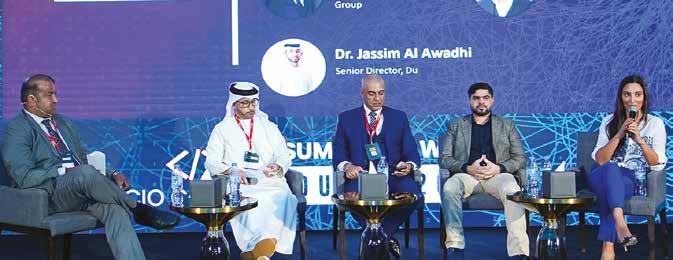

4. Loubna Imenchal, Head of Enterprise Business video collaboration, AMECA, Logitech
The second panel discussed ‘Managing Cloud Optimization’, addressing various approaches and elements of cloud optimization as well as aspects of cloud risk management.
The session was moderator by Gigi Mathew Thomas, Group IT Director, Ittihad International Investment LLC. The panelists in this session were
1. Ali Katkhada, Group CIO, Depa Group
2. Padam Kafle, Head of Innovation, Aster Digital Health
3. SatyaShankar Chirravuri, Head of Technology Platforms – Cloud & Se-


Aamir Mushtaq Shaikh
Lead – Channel Partnership and Alliance ME, Freshworks
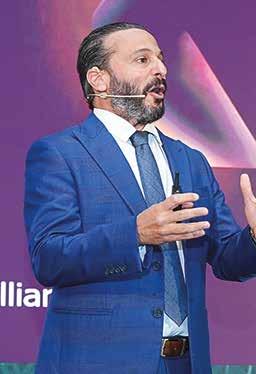
Samer Semaan Director Distribution and Alliances –META, Pure Storage
curity, Al Futtaim
4. Sunil Paul, CEO, Finesse
5. Darius Dordi – Cyber Security Manager at Sangfor Technologies
R. Narayan, Co -Founder and Editor in chief of Leap Media Solutions moderated the third panel that discussed Data Governance in the Era of Gen AI
The panelists in this session were:
1. Dr. Ebrahim Al Alkeem, Cybersecurity and AI Director, Abu Dhabi Government
2. Nisha Rani, CISO, MMI & ELR group
3. Prabhakar Posam, CIO, Transworld Group
4. Jishant Karunakaran, CEO, Mindfire Technologies
The final session focused on ‘Building cyber resilience in the multi-cloud’ that was again moderated by R. Narayan, Co-Founder and Editor in chief of CXO DX. The participants were:
1. Hussain AlKhalsan, CISO, Zand
2. Kausar Mukeri, CISO, Gems Education
3. Abhinav Kumar, AVP – Information Security, NMC Healthcare
4. Ankit Satsangi, Director BEEAH GROUP
5. Fouad Tawk, Area vice president –METNA for EXTRAHOP
Following the sessions, the Awards finale brought down the curtains on a very successful inaugural edition of the CIO Connect Summit and Awards.
Seif Aldin Abdul Karim Amina Hospital
Walid Salem Zurich Insurance Company
Ayman Medaka Drake and Scull International PJSC
Sabin Subramannian Park Regis Business Bay
Bashar Tuffaha Department of Culture and Tourism
Tony Issac Petrochem Middle East FZE
Gagandeep Singh Hoda Al Dahra
Roshan Bhosle GCC Services
Sajin Salim Abu Dhabi University
Zahid Ali Majestic Hotels
Pradeepkumar The Aquila School
Syed Manzar Abbas Rizvi Lifestyle LLC
Syed Ali Samaya Hospital
Sajai VK AMMT
Siddhu Kalliguddi Citymax Hotels
Touseef Sulaimani Prime Healthcare Group LLC
Sohan Bisht
Medcare Hospitals & Clinics
Muhammed Zawahir
Two Seasons Hotels & Apartments
Michael Brian Yeh Nova energy
Raja Sabqat Al Wahda Private School
Thomas Varghese Cavendish Maxwell Real Estate
Om Prakash Sharma Radisson Hotel Group
Vijay Sanku Lulu Group International
Alya Alnuaimi Ministry of Health and PreventionMOHAP
Rahul Cheruvelly Emirates Hospitals Group LLC
Shane Nicholas ABB Industries
Abdul Karim Bhatti Faysal Bank
Eyad Kashkash Department of Culture and Tourism
Muhamed Noufel
Royal Continental Hotels & Suites
Syed Tabran Ahmed Truebell Group of Companies
Shabeer Mangattu Parambil
Abu Dhabi University
George Kimani Havelockone
Arjun Bhattacharjee
Eli Lilly and Company
Manoj Mohan
Swiss International Scientific School
Mohammed Rizwan Razeek Al Matroushi group
Abdul Hameed Pharmatrade
Shiyas Gafoor
BM Hotels & Resorts
Faisal Qadri
Dubai World Trade Centre
Namshid PP Nesto Group
Hamza Sheikh Gulf Medical Co Ltd.
Shafahath Ashraf
Unique Group
Adam Lalani GCC Services
Aiman Aljabr Havelock One
Mohammed Ahteshamuddin flydubai
Hamda AlMaazmi Ministry of Health and PreventionMOHAP
Hemanth Shetty Omorfia Group
Haroun Dharsey Deem Finance
Mustansir Aziz Automech Group
Mohamed Arshad Alserkal Group LLC
Younis Othman Dubai customs
Mario Foster Al Ghurair Group
Aliakbar Patwa Arabian Gulf Steel Industries LLC
Khaqan shaheen Mir Plastic Industries
Ali Alauoubiy Department of Culture and Tourism
Shijin Prasad Cure Medical Centers & Cure Pharmacies, AL Nokhba Medical Centers
Riasat Ali RAK Ports
Vimal Rama Chandran HLB HAMT
Najim Abdullah Tayib BHM Capital
Ali Jumaily Sharaf Group
Dr. Lenish Kannan
Western International Group-Nesto/ Geepas
Ahmed Al Madani Horizon Terminals Ltd.
Abdalla Al Ali DMCC
Yasser Quraishy Manzil Healthcare Services
Mohit Duggar
Millennium Place Barsha Heights Hotel & Apartments
Kelly Machado Government - UAE
Aslam Abdul Kader Gulftainer Company Limited
SatyaShankar Chirravuri Al Futtaim Group
Aliasgar Bohari Zulekha Hospital
Salahuddin Almohammadi HSA Group
Arun Kumar Mohta FJ Group
Mohannad Hennawi NAFFCO
Joseph Aninias Abu Dhabi University
Shahood Siddiqui One Tech Capital
Ali katkhada Depa United Group
Sajith Pillai
Millennium Place Marina
Mahin Rasheed Sunset Hospitality Group
Imad Taha Belhasa International Group
Eng. Isha Aljassmy Ministry of Energy and Infrastructure-MOEI
Prabhakar Posam Transworld Group
Padam Kafle Aster Digital Health
Mohamed Shawky Emirates NBD
Sageer NK Burjil Holdings
Jaleel Rahiman Prime Healthcare Group
Joji Jacob Yusif Bin Yusif Fakhro BSC C
Farid Farouq Dubai World Trade Centre
Abdulrahman Khaiwi Emirates National Schools
Mohamed Alajmani Sharjah Customs
Mubarik Hussain Bloom Holding
Jayaraj Perumalsamy Barakat
Manny Johal Premiera Education Group
Ali Al Jasmi Khalifa Fund
Continuation from pg 21
Dr. Jassim Al Awadhi Du
Dr. Nasser Almuraqab University of Dubai
Gyan Prakash Srivastava Mashreq
Syed Ashar Ahmed EMAAR
Santosh Shetty Liwa Trading Enterprises
H.E.Mubaraka Ibrahim Emirates Health Services
Rushdy Mubarak Radisson Hotel Group
Saravanakumar Dhinakaran Bits Pilani Dubai Campus
Hendus Venter Jubaili Bros
Ebrahim Kamalzadeh Al Nabooda Automobiles
Gigi Mathew thomas Ittihad International Investment LLC
Bassem Al-Wazir NFPC
Mohammed Feroz Khan TOTAL Energies
Aiman Othman Union Coop
Rustom Pereira Emirates Insurance
Abhinav Kumar NMC
Jasmita Malik Majid Al Futtaim
Mohamad Mahjoub Veolia
Karthik Hemachandran Albatha Holdings
Tushar Vartak RAKBANK
Sarfaraz Muneer Mubadala
Sunil Kumar Nair Al Ain University
Prashant Nair
Airtel Africa PLC
Vishnu Chinnaraj Al Ramz P.J.S.C.,
Philippe Lopez Cigna Healthcare
Al Ratheesh. R Horizon Terminals Ltd.
Jijish Gopi Department of Finance Dubai
Ahmed Nabil Mahmoud Abu Dhabi Islamic Bank
Zaheer Shaikh
Al Maryah Community Bank
Vikalp Shrivastava Kerzner International
Faisal Khan
Dubai World Trade Centre
Santhosh Pillai
Emirates Digital Wallet
Hussain Alkhalsan
Zand
Waqas Haider
HBL Microfinance Bank
Rawda AlSuwaidi
Ministry of Health and Prevention-MOHAP
Nisha Rani
MMI & ELR Group
Ramakrishnan Natarajan
Emirates Hospitals Group
Kausar Mukeri
Gems Education
Ankit Satsangi
BEEAH Group
Dr. Ebrahim Al Alkeem
Ab Dhabi Government
Irfan Hussain
Havelock One
Chenthil Kumar
Red Sea International
Sultan Al Mansoori
Abu Dhabi Media
Ramadan Mohamad Ali
Ajman Transport Authority
Saqar Al Al
Sharjah Finance Department
Abhilash Radhadevi
OQ Trading
Bader Zyoud Abudhabi Media
Satyanarayana Kojapuram
SANAD – A Mubadala Company
Mukesh Kumar Apparel Group
Shaikha Ali Juma
Dubai Culture
AI Optimized Infrastructure Vendor of the Year Dell Technologies
Storage as a Service Vendor of the Year Pure Storage
Enterprise Cloud Networking Vendor of the Year Extreme Networks
EX Solutions Vendor of the Year Freshworks
Workspace Collaboration Solutions Vendor of the Year Logitech
Hybrid Workspace Security Vendor of the Year Accops
IT Management Solutions Vendor of the Year ManageEngine
Data Protection Solutions Vendor of the Year Acronis
Endpoint Security Vendor of the Year Sophos
SME Networking Brand of the Year D-Link
Enterprise Monitoring Vendor of the Year Paessler
NDR Solutions Vendor of the Year ExtraHop
Rising Cloud Solutions Vendor of the Year Sangfor
Hard Drives Storage Vendor of the Year Toshiba
Enterprise VAD of the Year Ingram Micro
Hybrid Technology Solutions VAD of the Year Logicom
Cloud Solutions VAD of the Year Mindware
Cybersecurity Marketplace of the Yea AmiViz
Information Security VAD of the Year Bulwark Technologies
Software Solutions VAD of the Year Grapheast
Datacentre Solutions VAD of the Year VAD Technologies
Collaboration Solutions VAD of the Year DVCOM
CX Solutions Provider of the Year DM World
Digital Transformation SI of the Year Alpha Data
Cybersecurity Solutions Provider of the Year Mindfire Technologies
Infrastructure Solutions Provider of the Year DigitalTrack Solutions
Cloud Solutions Provider of the Year Cloud Box Technologies
SOC Solutions Provider of the Year Finesse
Leading Managed Security Services by a Distributor Digi Glass
MBUZZ has rapidly expanded the range of solutions it offers through tie-ups with leading vendors and has invested in growth segments like AI solutions. Sabir Saleem, CEO at MBUZZ discusses various aspects of the company’s growth journey
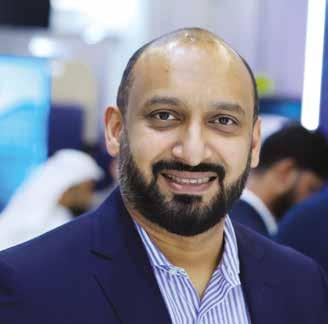 Sabir Saleem CEO, MBUZZ
Sabir Saleem CEO, MBUZZ
Discuss the growth and expansion that the company has achieved over the past year or so in terms of markets and products covered Over the past year, MBUZZ has made significant strides in both market expansion and product diversification, particularly in the realm of AI solutions. We have been focusing intensely on pushing AI solutions and have positioned ourselves as a leader in this rapidly evolving field in our region.
One of the key drivers of our growth has been our comprehensive, end-to-end AI offerings. We provide a full spectrum of
AI solutions, from hardware to software, and integration services. This holistic approach ensures that our customers receive seamless, turnkey solutions that meet their specific needs. Our portfolio includes advanced AI-powered tools for data analysis, machine learning, and deep learning applications, tailored to enhance various industry verticals such as healthcare, finance, retail, and more.
A significant milestone in our journey has been our partnership with NVIDIA as an Elite Partner. This prestigious partnership has not only enhanced our credibility but also allowed us to offer cutting-edge AI technologies powered by NVIDIA's stateof-the-art GPUs and software platforms. Being an NVIDIA Elite Partner means we have access to the latest innovations and resources from NVIDIA, which we leverage to deliver superior AI solutions to our clients.
Overall, the past year has been marked by robust growth and strategic advancements for MBUZZ. Our focus on AI, bolstered by our elite partnership with NVIDIA, has not only expanded our market presence but also reinforced our commitment to delivering innovative and comprehensive AI solutions. This positions us strongly for continued leadership and success in the AI landscape.
What are some of the recent initiatives from the company for your partners?
MBUZZ has recently implemented several key initiatives to enhance our partnerships and support our partners more effectively. One major initiative is our enhanced partner training programs. We've designed these comprehensive training sessions to equip our partners with the latest knowledge and skills necessary to leverage MBUZZ's products and solutions with the help of the Experience Centre.
We've also recognized the importance of collaborative growth, which is why we've initiated joint marketing campaigns with
our partners. These campaigns are tailored to boost brand visibility and market reach, providing opportunities for co-branding and shared resources for advertising, events, and digital marketing efforts. This collaborative approach not only enhances our partners' market presence but also reinforces our commitment to mutual success.
Additionally, to facilitate seamless integration of MBUZZ solutions with partner technologies, we offer dedicated support teams and integration tools. This initiative ensures that our partners can deliver cohesive and innovative solutions to their customers, driving mutual growth and customer satisfaction. Our support helps partners navigate technical challenges, fostering a smoother implementation process and enhancing overall product performance.
We've also introduced incentive and rewards programs aimed at motivating and recognizing partner achievements. These programs are designed to reward partners for their commitment and success in promoting MBUZZ products and solutions.
What are the solutions you offer in surveillance?
Our focus on the surveillance segment is a significant part of our strategy, particularly as the demand for advanced security solutions continues to grow. As the regional distributors of CP Plus, a leading brand in surveillance technology, we are well-positioned to offer a comprehensive range of high-quality surveillance solutions.
Our offerings in this segment include a variety of advanced security cameras, such as IP cameras, analog cameras, and PTZ (pan-tilt-zoom) cameras. These cameras are designed to provide superior image quality and reliability, ensuring optimal security coverage in various environments, from residential and commercial properties to large industrial sites. We have a wide range of Computer vision related use cases in the region, especially in KSA including Holy Mecca.
In addition to cameras, we offer sophisticated video management systems (VMS) and network video recorders (NVRs). These solutions enable seamless integration and management of surveillance footage, providing features like real-time monitoring, remote access, and advanced analytics. The VMS and NVRs we provide are designed to support scalable deployments, making them suitable for small to large-scale installations.
We also supply a range of accessories and complementary products, including storage solutions, power supplies, and network equipment, to ensure a complete and efficient surveillance setup. Our focus is not just on delivering products but also on providing comprehensive support and training to our partners and customers.
Elaborate on the role that your Experience centre has in your enablement services for partners and their customers? At MBUZZ, we place a strong emphasis on enablement services to ensure our partners and their customers can fully leverage our
products and solutions. A key component of these services is our state-of-the-art MBUZZ Experience Centre.
The Experience Centre is designed to be an immersive environment where partners and customers can engage with our latest technologies firsthand. Here, they can explore a wide range of products, from advanced surveillance systems to cutting-edge storage and networking solutions. The Centre provides a handson experience that allows users to see, touch, and interact with the technology, giving them a comprehensive understanding of its capabilities and applications.
In addition to showcasing our products, the Experience Centre serves as a training and demonstration hub. We offer tailored training sessions for partners and customers, focusing on product features, installation processes, and best practices. These sessions are led by our team of product experts and vendors, ensuring that participants gain deep insights and practical knowledge to optimize the use of our solutions.
The Experience Centre also facilitates live demonstrations and pilot testing. Partners and customers can bring their specific requirements and test our solutions in real-world scenarios, gaining confidence in the technology's performance and suitability for their needs. The Experience Centre also acts as a collaboration space where partners can meet with our technical and sales teams to discuss projects, address challenges, and develop customized solutions.
Discuss the focus on retail and gaming segments?
Our focus on the retail and gaming segments is a critical part of our overall strategy, leveraging our strengths and market expertise to drive significant growth in these areas.
In the retail segment, we have a robust presence on Amazon, where we are particularly strong. We have dedicated teams that work tirelessly to increase our strategic retail accounts on this platform. These teams focus on optimizing product listings, enhancing customer engagement, and driving sales through targeted strategies. We also leverage our powerful marketing team and extensive social media presence to direct more traffic to our Amazon page. This multifaceted approach ensures that our products are highly visible and appealing to a wide range of customers, thereby boosting our retail performance.
Our commitment to the gaming segment is underscored by our recent participation in Game Expo 2024. This event provided us with an invaluable opportunity to showcase our gaming-focused products and engage directly with the gaming community. By being present at such a prominent gaming event, we not only demonstrated our dedication to this segment but also gained valuable insights into the latest trends and preferences within the gaming community. This experience further fuels our focus on offering high-performance gaming products and engaging with gamers through various channels, including social media, events, and collaborations with influencers.
Digital transformation continues to revolutionize industries across the UAE, ushering in an era where data is king. In this landscape, organizations find themselves at the helm of an unprecedented volume of data, a veritable treasure trove that, if leveraged correctly, has the potential to dramatically enhance decision-making processes, assist in setting business priorities, and address complex challenges with data-driven solutions.
To help collect, sift through, and make sense of this multitude of information, companies are embracing cutting-edge technological solutions, such as machine learning, big data, analytics, and cognitive computing, however, AI is standing out with GCC countries leading the charge with its adoption in the Middle East and North Africa region. According to a McKinsey report, 62% of the organizations surveyed in the GCC are using AI in at least one business function.
With fast, informed decision-making becoming paramount in today’s rapidly evolving business environment, let’s look at some ways that AI can help streamline this process:
The integration of AI-driven data analytics into organizational strategies allows organizations to refine their focus, dedicating resources and attention to initiatives that directly support their strategic objectives and core business priorities. By harnessing AI algorithms to analyze complex datasets rapidly and accurately, organizations gain access to insights not readily detectable through traditional or human analysis. This capability can help drive organizations to prioritize efforts that yield the most significant impact, through a more precise alignment of their operations, research and development, and resource allocation. For instance, leveraging AI for predictive analytics enables accurate
 General Manager, GBM
General Manager, GBM
forecasting of market demands, allowing for optimized production schedules and inventory management, thus ensuring the realization of business priorities.
AI excels in identifying correlations and causal relationships within vast datasets, making it an invaluable tool for solving complex business challenges. Machine learning models can predict potential issues before they arise, allowing organizations to proactively implement solutions. For example, in the financial sector, AI can detect patterns indicative of fraudulent transactions, enabling companies to prevent losses. Similarly, in manufacturing, AI can predict equipment failures, facilitating timely maintenance and minimizing downtime.
In today's customer-centric business environment, leveraging data to understand
and predict customer needs, preferences, and behaviors is crucial. Through the analysis of customer interaction data, AI can help organizations predict customer needs and tailor their offerings accordingly. In particular, personalized marketing, targeted product development, and efficient customer service through chatbots and virtual assistants are just a few areas where AI is impacting the customer experience. AI-driven recommendation systems in e-commerce and streaming services ensure that customers receive personalized suggestions, significantly improving user satisfaction.
The strategic use of AI and analytics becomes indispensable in the quest for business growth and gaining a competitive edge. By deeply analyzing market trends, customer feedback, and competitive landscapes, AI not only identifies opportunities for innovation and new market entry but also provides actionable insights that can help drive revenue growth. This data-driven decision-making ensures that growth strategies are not based on intuition alone but are supported by actionable insights. Thus, organizations that can swiftly interpret and act on these insights are better positioned to lead, innovate, and seize opportunities.
To conclude, AI significantly enhances business decision-making by ensuring that an organization’s strategies and operations are not only data-driven but also forward-thinking. With the UAE on a mission to become an AI powerhouse and several initiatives being rolled out, such as the recent formation of the Artificial Intelligence and Advanced Technology Council, incorporating AI into business in this region becomes even more pertinent. Organizations that recognize and invest in the power of AI are poised for success in this new era, where informed decisions and strategic agility are the keys to sustainable growth and industry leadership.




Omar Akar, Regional VP, Middle East & Emerging Africa, Pure Storage says enterprises must design an AI journey that adds the right value for their unique business model in a way that is measurable
 Omar Akar Regional VP, Middle East & Emerging Africa, Pure Storage
Omar Akar Regional VP, Middle East & Emerging Africa, Pure Storage
The GCC has been experimenting with, piloting, and adopting artificial intelligence technologies for some time. Saudi Arabia has the National Strategy for AI and Data, Qatar has an Artificial Intelligence Committee, and the United Arab Emirates was the first nation to establish a ministry dedicated to AI. All this government apparatus was in place before generative AI arrived, which, in many ways, redraws the roadmaps.
In a region where governments and businesses are focused on issues such as health, public safety, sustainability, and economic stability, AI has a powerful pitch to make. It can accelerate time to market and time to value; it can enhance efficiencies from the back office to the factory floor, and from the warehouse to the field. It can alleviate risk by making market volatility, cyber threats, and even ROI more predictable. It can speed up R&D. AI is set to be the new standard foundation of competitiveness for enterprises everywhere.
It is understandable to be inspired by AI’s seemingly endless possibilities. But it is
in the implementation that value can become elusive if the right upfront investments are not made in resources and technology. The GCC’s focus on sustainability and societal enhancement also means that organisations must pay due attention to the environmental impact and energy strain associated with AI, especially the large-language models found in GenAI. However, hope lies in some research that suggests AI may be an important tool in reducing greenhouse-gas emissions by up to 10% by 2030.
So, enterprises must design an AI journey that adds the right value for their unique business model in a way that is measurable and therefore able to justify past and future budgets. And they must invest in the infrastructure that will allow them to offset carbon emissions to meet regulatory requirements.
The transformative benefits and value of successful AI projects far outweigh the challenges. Most industries are still in the early stages of adoption, but implementation is gathering steam as new use cases are defined and we move beyond the conservative thinking that prevails within many organisations. In preparation for this shift, regional enterprises must start thinking about what is required to ensure solid foundations are in place for an AIbased future.
To ensure the success of the AI, journey, here are the key issues organisations must address:
Supply chains must be assessed and factored into any AI roadmap from the outset. Access to GPUs is critically important as without them, AI projects cannot succeed. As regional AI adoption soars, the already significant demand for GPUs will affect the supply chain, and some organisations planning AI implementations may need to look to service providers for access to the technology.
Successful AI projects need massive datasets, which creates challenges for already stretched data centres, particularly in relation to power consumption. Modern AI implementations can demand power densities of 40 to 50 kilowatts per rack — well beyond the capability of many data centres. AI is a game changer for the network and power requirements of today’s data centres. A much higher density of fibres is required, together with greater, higher-speed networking than traditional data centre providers can deliver. Power- and space-efficient technologies will be crucial to the success of AI projects. Flash-based data storage can help mitigate this problem, as it is considerably more power- and space-efficient than HDD technology and requires less cooling and maintenance than traditional hard drives. Every watt allocated to storage reduces the number of GPUs that can be powered in the AI cluster.
Unlike other data-based projects that can be more selective in the storage and access of data, AI projects need extremely large data sets to train models and extract insights to fuel new innovation. This presents major challenges, especially when it comes to fully understanding AI models and predicting how the introduction of
new data may change outcomes. AI professionals are still grappling with the issue of repeatability but a best practice to help understand data models and very large datasets is to introduce “checkpointing”. This ensures models can be easily returned to earlier states, thereby facilitating a better understanding of the implications of data and parameter changes. The ethical and provenance aspects of using data from the Internet in training models are also yet to be sufficiently addressed. The same goes for the possible impacts of removal of selected data from an LLM or RAG (retrieval augmented generation) vector dataset.
Any GCC organisation will face talent shortages on its AI journey. There is a worldwide shortage of data scientists and other AI professionals. As a result, AI-skilled people are difficult to secure, and command premium salaries. This is likely to remain a significant issue throughout the coming decade. So, organisations will need to not only invest heavily in talent through recruitment, but also upskill or reskill their existing workforce.
The GCC shows remarkable maturity in its AI journey, including its identification of use cases, its recognition of the need for infrastructure investment, and its prioritisation of the skilling and upskilling of its workforces. Progress has been made in part through identification of a fundamental truth — that the AI journey is best taken in allegiance with others. Whether for skills, infrastructure, or consultation, partnerships can be the difference between success and failure. Across the region, cloud service providers, managed service providers and others have an opportunity to step forward and join hands with AI innovators to make their journeys smoother. In collaboration, partners in AI can build the future for the region — insights-driven, sustainable, and globally competitive.
“Modern AI implementations can demand power densities of 40 to 50 kilowatts per rack — well beyond the capability of many data centres. AI is a game changer for the network and power requirements of today’s data centres. A much higher density of fibres is required, together with greater, higher-speed networking than traditional data centre providers can deliver”
Legacy infrastructures are blocking the way forward for many aspiring regional enterprises wanting to adopt artificial intelligence and the way forward is to partner with specialized players who can help them in this transition, says Rindhir Singh, Head of Practice, Connectivity and Cloud at NTT DATA MEA.
 Rindhir Singh Head of Practice, Connectivity and Cloud, NTT DATA MEA
Rindhir Singh Head of Practice, Connectivity and Cloud, NTT DATA MEA
According to IDC, spending on artificial intelligence in the Middle East and Africa, will reach $3.0 billion in 2023. While this will account for just 2% of the global total for 2023, that is $151.4 billion, the region will see the fastest growth rate worldwide over the coming years. IDC forecasts that artificial intelligence spending in Middle East and Africa will increase at a compound annual growth rate of 29.7% over the 2022–2026 period, reaching $6.4 billion in 2026.
The rapid adoption of cloud and digital transformation in Middle East and Africa will result in artificial intelligence being incorporated into many different products and solutions. Organizations across the region are investing in artificial intelligence technologies and related software and services to drive greater efficiency through automation and contribute to a more agile operating environment.
Banking, retail, and government will be the region's biggest spenders on artificial intelligence, followed by discrete manufacturing. Together, these four industries will account for nearly half of the region's total artificial intelligence spending. Professional services and transportation are expected to be the fastest-growing industries over the forecast periods.
Augmented customer service agents, fraud analysis and investigation, augmented threat intelligence and prevention systems, and sales process recommendation and augmentation are some of the leading business use cases, according to IDC.
While digital platforms such as cloud and artificial intelligence are opportunities for regional enterprises to accelerate their transformation into digital enterprises, many regional enterprises are also struggling with technological debt.
For regional enterprises, a significant ongoing challenge is making the leap from aging infrastructure to a future-forward ecosystem that supports business growth in a way that is collaborative, cohesive and secure. Intelligent and autonomous solutions can be delivered from a networking infrastructure platform that is scalable, agile, reliable and software defined.
Legacy systems and processes do not leverage modern day capabilities like network automation. Configuration changes, upgrades, modifications, scale-up additions, need to be done manually, which are both time consuming and expensive because of the complexity and sprawl.
Legacy systems also struggle with lack of interoperability and exist in silos. This means changes will also be done in silos and in a limited manner. The impact on the overall network fabric to help the enterprise move forward in its transformation journey may be limited and difficult to predict beforehand.
IT infrastructure managers in regional enterprises therefore face various decision-making steps and need to consider the following:
• How do you select the right partner in an overcrowded market to help you transition to the next generation networking infrastructure?
• Do you have the right internal skills to manage the next generation of network operations, or do you need to consider outsourcing this management operation?
• Will transition to the next generation networking infrastructure help you to sufficiently manage, understand and enhance the user experience?
• Will the migration away from legacy infrastructure to next generation infrastructure be sufficient to manage enterprise transformation?
To achieve the above, regional enterprises should be aspiring to successfully build an outsourced, outcomes-based solution that targets the infrastructure and software layers. The focus needs to be on the infrastructure layer with the network fabric that connects cloud, data centres and hybrid IT operations.
The application software and infrastructure components of the network are orchestrated through an automated and programmable mechanism that is fast and efficient. This derives insights from the top IT and data layer, using AIOps, predictive analytics and automation to enhance efficiency, security, performance, and monitoring. Using artificial intelligence-tools, this data-led approach monitors and enhances user experience.
The result is an application-centric network that works across the entire enterprise, whether on-premises, in the cloud, or in data centers, with limited human intervention.
Once this infrastructure is in place, regional enterprises can manage the infrastructure using various intelligent and predictive tools and gain the benefits listed below:
Using artificial intelligence, applications are now much more than technical tools. They are part of a symbiotic ecosystem that is continually learning from usage and improving its performance.
The optimization of a network involves multiple factors. End-toend visibility, application and tool management, bandwidth usage management, are now available and can help to improve the performance of business-critical and other workload applications.
Automated security policies and management on a single platform, understanding of how to process and safeguard data between users and applications, protecting data from intrusions, now help to deliver this use case.
AI-driven incident monitoring and management reduces the number of incidents by 90%, remediates threats to the network in the shortest possible time, and provides early warning of potential network failures. artificial intelligence and analytics-driven usage and capacity planning improves the health of the network through better visibility and observability.
AI-based predictive maintenance can isolate anomalies and analyze which areas of an IT ecosystem are at risk, days and weeks in advance. This allows potential network infrastructure issues to be addressed before they happen. Insights generated from networking data help to understand the network trends.
By partnering with specialist networking infrastructure players, regional enterprises can successfully abandon legacy environments and begin to gain the benefits of an intelligent and autonomous, AI eco-system environment.
“Banking, retail, and government will be the region's biggest spenders on artificial intelligence, followed by discrete manufacturing. Together, these four industries will account for nearly half of the region's total artificial intelligence spending.”
Ekta Puthran, Head of Sales APAC & MEA - Collaboration, Barco writes that the future workplace needs to become an inclusive environment where employees are productive and can easily collaborate, whether they're working from home or in the office
 Ekta Puthran Head of Sales APAC & MEA –Collaboration, Barco
Ekta Puthran Head of Sales APAC & MEA –Collaboration, Barco
The workplace has changed significantly more in the past 5 years than in the 50 years before. New work methods, such as remote work, predominantly office-based work, and all the hybrid forms in between, are now possible. To keep up with these changes, IT managers must reimagine the office environment. What are the best investments for IT managers from companies focusing on productive hybrid working and making their office attractive?
Major players like Apple, Meta, Zoom, and Amazon are still grappling with hybrid working and are seeking ways to get their employees back to the office. Does mandating employees to return to the office help? No, that's certainly not the right solution. Mandates, rules, and policies only lead to frustration and demotivation.
So, what really helps? Creating a workspace that employees want to return to. Integrating elements like comfortable furniture, natural lighting, and even wellness spaces can significantly enhance the appeal of the office. Companies are particularly well-positioned to lead this transformation in the UAE and Saudi Arabia, where the focus on innovation and modernization is strong. These countries have seen significant investments in smart city projects and advanced infrastructure, providing a solid foundation for modern, attractive workplaces.
While everything hinges on creating a good employee experience, focusing on employee experience fosters increased morale and productivity and contributes to lower attrition rates and a positive business reputation.
According to a Gartner survey in 2023, as many as 12% of employees are considering changing jobs if their employer doesn't provide a hybrid work strategy. On the other hand, 84% of IT managers, Employee Experience is a strategic priority, according to Investment Priorities for the Workplace and Video Conferencing, Frost & Sullivan, 2023. This highlights a critical need for companies to adapt.

It's often challenging for companies to set up their offices in a way that allows employees to have meaningful interactions, collaborate optimally, and truly connect with each other—wherever they are; only then do employees feel connected, appreciated, and motivated. Companies need to focus on building a culture of inclusivity and support to strengthen these connections. To modernize the workplace, an organization must address not only the corporate culture and the design of physical workspaces, but also invest in new technology.
Cultural values and traditions are integral to business practices in the region and creating workplaces that respect and integrate these values is essential. For instance, having prayer rooms and areas that accommodate cultural practices can greatly enhance employee satisfaction and inclusivity.
The future workplace must facilitate hybrid working. It needs to become an inclusive environment where employees are productive and can easily collaborate, whether they're working from home or in the office. Employees working from home need to feel seen and heard in hybrid meetings. Everyone should have equal opportunities to contribute wherever they dial in for a meeting. And that's where the right video technology comes in.
Technology transformation and a video-first approach in meetings is intertwined with reshaping a modern, employee-centric workplace. The value of high-quality audio & video communication in meetings is deeply entrenched across the hybrid organization. Today, however, employees can organize video meetings in less than 15% of spaces according to Investment Priorities for the Workplace and Video Conferencing, Frost & Sullivan, 2023. That's why many IT managers are looking for seamless solutions to equip meeting rooms with video. According to that same research, 95% of IT decision-makers are actually planning office
changes to support remote and hybrid work and meetings in the coming year.
When selecting wireless video conferencing and collaboration solutions, they focus on the reliability, ease of use, security, and interoperability of the technology. Other important factors influencing their choice include flexibility, efficient management, and easy installation of solutions. Ensuring that these solutions are user-friendly and require minimal technical support is essential to reduce downtime and increase productivity.
We see productivity solutions such as ClickShare offering IT managers unparalleled flexibility and simplicity, by eliminating messy cables, complicated setups, and limited functionality. With just one click on the ClickShare Button or App, a user can start a meeting in less than 7 seconds and connect their laptop to the audio and video equipment in the meeting room.
This juncture marks a pivotal moment in workplace transformation. By successfully navigating this transition, companies can set a new standard for the future of work. A misstep could discourage efforts to rebuild connectivity, while success could herald a new way of working characterized by an enhanced employee experience, seamless connections, and empowered and efficient employees. With the right technology to ensure great user experiences and equal participation for all meeting attendees, IT managers can find with peace of mind and more flexibility.
The key to creating an attractive workspace lies in understanding and addressing the evolving needs of employees. By focusing on technology, design, and culture, IT managers can transform offices into vibrant, productive hubs that draw employees in and foster a thriving work environment.
When basic security controls such as MFA and password enforcement are not in place, your organization is vulnerable writes Morey
Haber, Chief Security Advisor, BeyondTrust Morey Haber Chief Security Advisor, BeyondTrust
Morey Haber Chief Security Advisor, BeyondTrust
Nothing reinforces the “it could happen to any of us” mindset of the modern CISO like a good headline, especially when the victim is a Big Five tech player. Surely, they are protected to the hilt. Surely, they are impervious. But no. The echo of the New Year gong had barely faded when security leaders in the GCC, and around the world, were reading about Microsoft’s tangle with Midnight Blizzard. Alternatively known as “Nobelium”, “APT29”, “UNC2452”, and the somewhat cuddly “Cozy Bear”, the Russian state-sponsored (according to Microsoft) social-engineering specialist was reportedly behind the 2021 SolarWinds infiltration. In January, this decidedly non-cuddly “Bear” compromised the tech giant with a simple password-spray attack that began in November. From the hijack of a test tenant account, Midnight Blizzard moved laterally to take over several other corporate accounts, including those of top executives — even those of cybersecurity leaders.
So, let the lesson-learning begin. First, the classics still work. Password-spray attacks have been around forever. They differ from a brute-force attack, in that they hit a large quantity of accounts with the most common passwords — “12345678”, “Passw0rd”, and so on — rather than focusing on a single account by trying every possible password. The attack method also tries one chosen password at a time against each account on the attackers hit
list, which is stealthier because it prevents lockouts. Second, the threat gang (may have) made off with some (undisclosed) data, indicating, once more, that even the largest enterprises are at risk. Third, Microsoft’s own investigation concluded that the attack was not tied to a vulnerability but rather to the absence of multifactor authentication (MFA) in legacy systems. So, “practices make perfect”, as in “best practices”. So, let’s look at some now to ensure the region’s enterprises do not fall prey to a Microsoft-style drama.
It is crucial to understand that the absence of robust passwords, multifactor authentication, and other standards is, by definition, the absence of strong management principles. If we want to talk in terms of blast radius, we minimize damage by minimizing the number of accounts that are not following the right protocols. Strong passwords are the enemy of spray attacks so good password management is the enemy of spray attacks. Such attacks succeed more commonly when targeting cloud-native applications because they are seldom monitored for failed logon attempts and also tend to not use modern practices such as MFA.
Password management is as straightforward as it sounds. It provides a digital means of looking over each user’s shoulder to ensure they change their passwords regularly, use sufficiently complex ones when they do so, and do not duplicate them across resources. Enterprise password management solutions are available for such purposes and are well worth the investment, especially if one considers Microsoft is not the only cautionary tale that illustrates the potential consequences of inaction. These platforms are hygiene enforcers and best-practice disciplinarians for human and machine accounts alike. Apart from password oversight, they are capable of managing privileged sessions in real time to flag potential threats and, if necessary, pause or terminate a session to protect the environment.
2. Multifactor authentication
Password-spray attacks can sometimes be defused by password hygiene alone. But to really frustrate the threat actor, security teams should implement MFA. While this is important for all users, it becomes all the more critical for privileged accounts. While no cybersecurity measure is foolproof and bench-testing reports on MFA do vary, some results show protection factors of above 99.99%, meaning less than one in 10,000 attempts on an MFA-protected corporate account will succeed. MFA is a concrete hurdle for attackers and provided phishing-resistant variants such as FIDO2 (which uses public-key cryptography and is stronger than SMS-based OTPs) are implemented, an organization can consider itself strongly protected.
Once an attacker has compromised the right account, they can do the kind of damage that makes headlines. They can poke around intellectual property, plant ransomware in multitier backup systems, send convincing emails from genuine corporate accounts, and much more. Assuming an organization has effective password management and MFA in place, we are now discussing a
highly unlikely occurrence, but that does not mean we should not prepare ourselves. If an attacker does get this far, our next objective is to limit their opportunities for lateral movement. This can be achieved by adhering to the principle of least privilege (PoLP), where every user and machine account is granted only those permissions necessary to carry out their function. PoLP also happens to be one of the pillars of zero-trust environments, which are becoming increasingly popular in the GCC, and is most commonly implemented through an endpoint privilege management solution.
When basic security controls such as MFA and password enforcement are not in place, your organization is vulnerable. These problems are inflated if you do not have the means to promptly detect and close security gaps. Any lag between the start of attack-related activities and their detection by the enterprise is a boon to the attacker and a risk to the target. Identity threat detection and response (ITDR) can proactively mitigate poor identity controls by flagging gaps before they are exploited. ITDR goes further though because it can also swiftly detect and respond to attacks as they occur.
Password-spray attacks do not target system vulnerabilities; they target us. The human capacity to settle for what keeps the gears of our lives turning — personal, commercial, governmental — is understandable. But it is exactly this tendency that spray attacks exploit. And all that stands between threat actors and those aforementioned life gears are the best practices mentioned here. Microsoft endured a lot of inconvenience to teach us some valuable lessons about the basics of cybersecurity. It would be a shame to let that go to waste.
“Strong passwords are the enemy of spray attacks so good password management is the enemy of spray attacks. Such attacks succeed more commonly when targeting cloud-native applications because they are seldom monitored for failed logon attempts and also tend to not use modern practices such as MFA.”
The Latitude 7455, the first Copilot+ Latitude, and Dell’s first with Windows 11 Arm, has powerful on-device AI and exceptional speed and efficiency in a premium Latitude design. It is a premium AI laptop up to 21 hours of battery life stacked with a stunning 14-inch QHD+ touch display, quad speakers with AI noise reduction, Qualcomm FastConnect Wi-Fi 7 and optional 5G for greater connectivity
and collaboration. As Dell’s thinnest Latitude laptop ever, team members have the mobile form factor they need for productivity at the desk or on-the-go. The all-aluminum chassis is built with a combination of low emissions and recycled aluminum. The Latitude 7455 powered by up to Snapdragon X Elite effortlessly tackles complex workloads.
It offers a 16:10 screen that allows you to see it all clearly with the crisp QHD+ resolution. At just 0.67 in. (16.90 mm) and with a durable Titan Gray aluminumtop ever and looks sleek and professional

Highlights:
• Streamline your workflow and increase productivity with Copilot, an AI assistance tool that summarizes emails, analyzes spreadsheets, drafts proposals, creates presentations and more. With Microsoft 365, you can stay organized, collaborate and get work done in a snap.
• Present your ideas more effectively with custom images through Cocreator in Paint. Use the tool to transform rough sketches and prompts into polished visuals. Adjust until the design is exactly as you envisioned, or even better.
• No need for extra lights or soundproof rooms—new Windows Studio effects help you look and sound your best. Voice Focus filters out background noise and makes sure you are heard. This AI-enabled feature improves lighting and blurs distractions, so you’re always the focus.
• With Live Captions, you stay connected and never miss a conversation. Instantly translate your video calls or movies from any app or video platform into English subtitles, in real time.
These cutting-edge Mesh Systems are engineered to address the three most common pain points of Wi-Fi users: coverage, speed, and usability. Featuring built-in AI technology, the AQUILA PRO M30 Wi-Fi 6 Mesh Systems are set to revolutionise the home networking experience. The AQUILA PRO AI M30 has also won a prestigious 2023 Good Design Award.
Drawing inspiration from the Aquila constellation (Latin for eagle), the M30's design concept is a unique evolution of traditional router design. The AQUILA PRO AI M30 boasts an elegant, wall-mountable design to seamlessly blend with any decor and its five upgraded internal antennas provide wider, more spherical coverage, making the M30 an ideal centrepiece for any connected home.
As part of "D-Link Green", D-Link’s long-running environmental initiative, the AQUILA PRO AI M30 closely adheres to green design principles.
• The AQUILA PRO AI M30 masterfully combines aesthetics and functionality, providing a hassle-free Wi-Fi solution that delivers seamless connectivity, lightning-fast speeds, and high levels of usability across your home network.
• The AQUILA PRO AI M30 employs innovative AI technology, including an AI Wi-Fi Optimiser, AI Mesh Optimiser and AI Traffic Optimiser to ensure superior Wi-Fi performance for all your devices.
• The M30 leverages the Wi-Fi 6 Target Wake Time (TWT) feature to reduce power consumption and offers a health
Logitech has unveiled the MX Brio/ MX Brio 705 for Business, a highend webcam for end users and enterprises, which is designed to meet the demanding needs of advanced users. The MX Brio is its most advanced webcam yet and joins the Master Series ecosystem alongside MX keyboards and mice to deliver streaming experiences while fostering quality collaboration, says Logitech. The Ultra HD 4K webcam helps creative professionals and developers elevate their virtual presence and efficiently share results and ideas.
MX Brio’s Ultra HD 4K resolution and advanced webcam sensor demonstrate Logitech’s continuous innovation with 70% larger pixels than the Brio 4K, its previous flagship webcam, offering an ultra-sharp image. AI-enhanced image quality takes auto light correction further with face-based image enhancement that provides a more natural image, and video with 2x better face visibility and 2x finer image details in difficult lighting conditions compared to Brio 4K, as tested by DXOMARK lab.
The webcam is certified carbon neutral, like the rest of Logitech’s products, and the paper packaging comes from FSC-certified forests and other controlled sources.
Highlights:
• Advanced customisation options allow users to fine-tune their appearance by manually adjusting exposure, tint, vibrance, field of view and more using Logi Options+, Logi Tune, and G HUB software.

• RightSight auto framing feature, which detects and centres on the speaker even as they move around, can be enabled through Logi Tune for enterprise customers with MX Brio 705.
• Show Mode makes it easy for users to share sketches or other physical objects on their desks by simply tilting the webcam.
• MX Brio also has two beamforming mics to reduce background noise so you can be heard clearly, alongside an integrated privacy shutter.

• For IT teams outfitting employee workstations and home offices, MX Brio 705 for Business, the plug-andplay enterprise model, is compatible with most video conferencing platforms, certified for Microsoft Teams, Google Meet, and Zoom, and works with Chromebook.
mode that automatically turns the router into an ultra-low power standby mode during the night ensuring energy efficiency. Compatible with Amazon Alexa and Google Assistant voice control, users can effortlessly manage their smart home.
• The AQUILA PRO AI M30 Wi-Fi Mesh Systems use a special antenna array designed to extend a stronger WiFi signal, boosting spherical coverage and eliminating dead zones.
• Powered by Wi-Fi 6 technology, the AQUILA PRO AI M30 delivers extreme speeds of up to 3Gbps, supporting 160MHz bandwidth, along with a Gigabit Internet WAN port and four Gigabit LAN ports supporting wired devices such as smart TVs, gaming consoles, and PCs.
• The AQUILA PRO AI M30 complies with the latest WPA3 encryption and IEC 62443-4-1 standards, safeguarding your network against unauthorised access.
Predicted Year-over-Year Growth of More Than 20% Spurred by GenAI-Enabled Applications at Scale
Worldwide end-user spending on public cloud services is forecast to grow 20.4% to total $675.4 billion in 2024, up from $561 billion in 2023, according to the latest forecast from Gartner, Inc. This growth is being driven by generative AI (GenAI) and application modernization.
“The continued growth we expect to see in public cloud spending can be largely attributed to GenAI due to the continued creation of general-purpose foundation models and the ramp up to delivering GenAI-enabled applications at scale,” said Sid Nag, Vice President Analyst at Gartner. “Because of this continued growth, we expect public cloud end-user spending to eclipse the one trillion dollar mark before the end of this decade.”
All segments of the cloud market are expected to see growth in 2024. Infrastructure-as-a-service (IaaS) is forecast to ex-
perience the highest end-user spending growth at 25.6%, followed by platformas-a-service (PaaS) at 20.6% (see Table 1).
“IaaS continues at a robust growth rate that is reflective of the GenAI revolution that is underway,” said Nag. “The need for infrastructure to undertake AI model training, inferencing and fine tuning has only been growing and will continue to grow exponentially and have a direct effect on IaaS consumption.”
While cloud infrastructure and platform services are driving the highest spending growth, SaaS remains the largest segment of the cloud market in end-user spending. SaaS spending is projected to grow 20% to total $247.2 billion in 2024.
“SaaS spend is driven by applications being modernized by independent software vendors to run in a SaaS-based
consumption model,” said Nag. “Organizations continue to increase their usage of cloud for specific use cases such as AI, machine learning, Internet of Things and big data which is driving this SaaS growth.”
In the Middle East and North Africa (MENA) region, end-user spending on public cloud services is forecast to grow 19.8%, to total $7.3 billion in 2024.
“Public cloud spending is expected to surge as companies in the MENA region are moving towards becoming fully digitalized corporations. Additionally, Middle Eastern countries are also looking for a common economic goal of becoming technology and data centric. Organizations are using cloud as an enabler of technologies such as AI and business analytics to enhance the capabilities,” said Shailendra Upadhyay, Senior Principal Analyst at Gartner.






